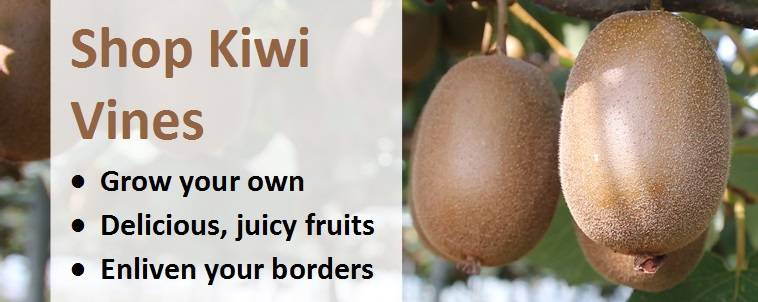Check Here Before Buying – Pot Size Matters...Not all websites offer the same. Plants in a 2-litre pot have twice the root system of a P9 or 1 litre pot.
How to Grow Your Own Kiwi Plant
Kiwi vines are vigorous, hardy, easy to grow deciduous woody climbing plants originating from southern China, although most kiwi fruit sold in the UK now comes from Italy. Once established they can become very vigorous, so need plenty of space, regular pruning and a strong support structure such as a trellis, pergola or arch. They are best sited against a warm south-facing wall and will deliver heavy crops of uniquely textured and flavoursome fruit, even in the UK's climate, once established. Only one plant is necessary if a self-fertile kiwi variety is chosen, otherwise plant female and male varieties together to ensure good pollination. If you're planning to grow a mini kiwi orchard with plants that are not self-fertile, choose at least one male (non-fruiting) variety to pollinate up to eight female plants. In almost all situations a self-fertile variety is best because they can be grown as single plants, helpful to save space in all but the largest of gardens, and varieties that are not self-fertile are notoriously difficult to pollinate because the flowers are not very attractive to bees.
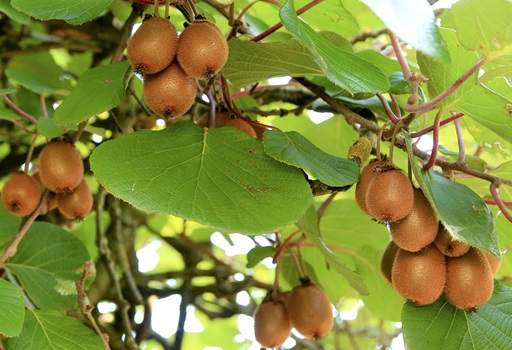
Kiwi vines are vigorous once established, so need plenty of space
Fruit
Kiwi plants should be a serious contender for any spacious kitchen garden. They produce an abundance of delicious small, sweet furry brown fruits around the bases of the current seasons' shoots in late summer. Inside the fibrous, dull greenish-brown skin, kiwi fruits have soft textured bright green or golden flesh with a sweet but unique flavour and rows of the characteristic tiny, black, edible seeds. Kiwi fruit is high in vitamin C (twice as much as an orange) and can be used in a variety of savoury and sweet dishes, including fruit salads and atop pavlova desserts. An interesting fact about kiwi fruits is they were originally sold under the name "Chinese gooseberry", but then re-named to kiwifruit after the kiwi bird as the bird and the fruit share a similar appearance and both are associated with New Zealand (where most early kiwi plantations were based)
Recommended Kiwi Variety
The best kiwi variety is:
Kiwi Jenny- ‘Jenny’ is one of only a few self-fertile kiwi plants available, ideal if you only have room for one plant. Red tipped, heart shaped foliage is accompanied by small white flowers in the summer. The delicious fruits are ready to be harvested in late summer to autumn, each one being approximately the size of a hen egg. It will produce fruit around 3 years after planting.
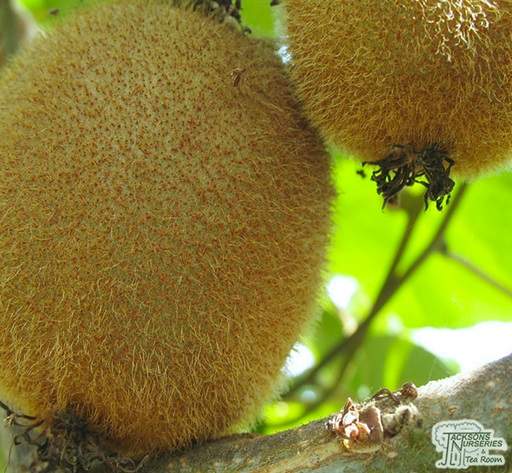
Planting Advice
Favourable planting conditions are essential, particularly as kiwi plants become established, because they can be quite fussy. The vines need plenty of sunlight and shelter to survive, so choose a south-facing site shielded from low winter and early spring sun by buildings or trees. Kiwis also require a fertile, well-drained, acidic soil rich in organic matter; we do not recommend planting in poor or chalky soils. If you're soil doesn't drain well, plant each vine atop a raised mound of earth to avoid the top part of the root system sitting wet. Kiwis require plenty of space - allow a minimum of 3 and up to 4.5 meters if possible. They are suitable for container growing, which is normally the preferred option if ground conditions are not quite perfect, as container grown specimens can then be planted out once 4-5 years old when less fussy about the soil conditions. Container grown plants will also demonstrate very rapid growth if carefully watered and regularly fertilised; just ensure they are not over-fertilised before the winter cold as late new growth will be more vulnerable to the frost. Planting is best undertaken between late autumn and early spring.
Kiwi plants need training or trellising as they grow as a woody vine which is not sturdy enough to support the plants once mature. When considering the location of your kiwi plants, either plant near an existing support such as a pergola or arch or add your support system before planting. They are best trained to a support that is both sturdy and allows vines adequate room to ramble; gazebos or split rail fences are also perfect.
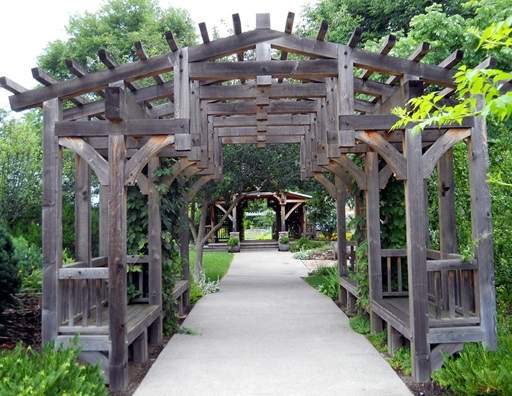
Train your kiwi vine up a sturdy support structure
Winter Cold Protection
A benefit of container growing is that it also allows your kiwi plant to be protected for its first couple of winters in an unheated greenhouse, garage or outbuilding. If planting out into the ground straight away, provide protection from frosts in the winter by wrapping insulating but porous materials around the base of the trunk. However, Kiwi plants must be exposed to some cold in the early days to develop frost hardiness, so don't be too eager to mother your vine (the technical guidance is to provide winter cold protection if frost penetrates the ground by more than one inch). Watch out for bitter frosts in early spring too!
Watering, Weeding & Feeding
Mulch with well-rotted manure or garden compost around the base of your kiwi plant in late winter, avoiding contact with the trunk as this may cause rotting. Just like their native habitat, your kiwi plants should receive a steady water supply and should never be allowed to dry up. As a rule of thumb, water once a week during warm, dry summers. We also recommend applying a slow release multi-purpose fertiliser in the spring as soon as new growth starts to show. Be sure not to apply fertiliser after July as this will encourage too much late growth which is most susceptible to winter frost damage.
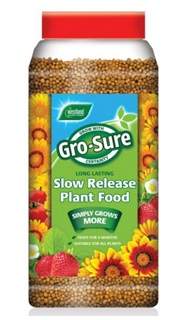
Apply a slow release multi-purpose feed around the base of your kiwi vine in spring
Pollination, Fruiting and Harvesting
Kiwi vines start to produce fruit 3-4 years after planting, with pollination mainly being done by bees, although a range of other insects also help. A much improved harvest will be experienced by choosing a self-fertile kiwi variety such as Kiwi Jenny. Pick your kiwi fruit around early autumn and certainly before the first frost, before it is fully ripe. Kiwi fruit taste better if they ripen away from the plant, rather than on the vine. Quick ripening can be induced by placing the fruit alongside apples in the fruit bowl or (even quicker) in a punctured plastic bag with an apple, if you're impatient to taste your harvest! To check whether kiwis are ready to harvest, take a couple from the vine and put them in the fridge. If they taste sweet after 3-5 days, they are ready to be harvested.
Remove kiwi fruit from the vine by snapping them off their stalks, being careful not to bruise the fruits when picking. The fruit will be hard, but will soften and sweeten in a week or two at room temperature. You may wish to experiment with the timing of harvesting your fruits each year to determine the time to pick and duration to ripen for optimal taste. Kiwi fruit can be stored for up to 6 weeks in a cool room, 3 months in a pierced plastic bag in the refrigerator or 6 months in a plastic bag with small holes in the freezer. Ripening takes place between a few days and a week at room temperature.
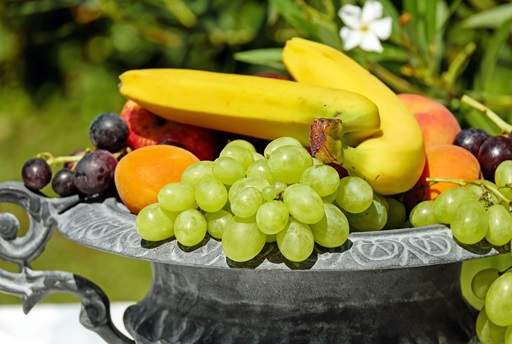
Kiwis will ripen within 3-5 days in the fruit bowl
Top Tip: Do not keep your kiwi fruits in sunlight when ripening.
Pruning and Training
An established kiwi plant consists of a trunk, permanent cordons and fruiting side-shoots. They're are best trained as espaliers on horizontal wires with a main vertical shoot trained to your preferred height, then horizontal branches tied to the horizontal section of your support structure, or horizontal wires. Side-shoots will develop perpendicular to the horizontal branches which will bear fruit at their base.
More specifically, training involves tying shoots to supports and pruning the plants firstly during the summer growth phase and again whilst they are dormant in late winter. Start by training the strongest shoot up (not around) a pole, thick bamboo cane or other support, tying it in at regular intervals - this will form the trunk of your kiwi plant. If you're kiwi plant has been grafted, ensure the strong shoot you choose is above the graft. If the chosen shoot grows wearily in the first year (e.g. not reaching 30-45cm or 1-1.5 feet) cut it back by half whilst dormant in late winter to stimulate vigorous new growth the following year. It's best to develop two cordons - one either side - from the trunk once it starts to exceed the height of your horizontal level support.
In the first dormant (winter) season after the cordons have formed, shorten them to around 60cm and remove all excess growth along the cordons and the trunk. Every year thereafter, shorten the cordons each dormant season, leaving 60cm of growth from the current growing season on each occasion, until they each reach 2m from the centre of the plant (i.e. total spread of kiwi plant 4m). After this time, cut back each cordon to 2m each dormant season. Fruiting side-shoots will grow out perpendicular to and be draped over the wires. Any side-shoots which are not spaced 30cm apart on opposite sides of the cordon should also be removed in the winter.
Summer pruning is also vital to keep vigorous kiwi vines under control and within their designated bounds. Firstly, remove any shoots that form from the trunk as soon as they are noticed. Secondly, cut back any excessively rampant side-shoots growing from the cordons to short stubs, leaving buds to allow the plant to develop new side-shoots. Thirdly, continually thin out any crossing or spindly vines to ensure good air flow through your kiwi plant. Finally, once the fruit has set, pinch back the side shoots, leaving 4-5 leaves beyond the maturing fruit.
Overall, the goal in training and pruning are to avoid your kiwi becoming a tangled mass of rampant shoots and instead maintain a manageable, easy-to-harvest vine with adequate light and air circulation to encourage a plentiful harvest. Additionally, regular pruning will also encourage more new growth to develop each year, which increases production because kiwi fruit are borne at the base of the current season's growth.
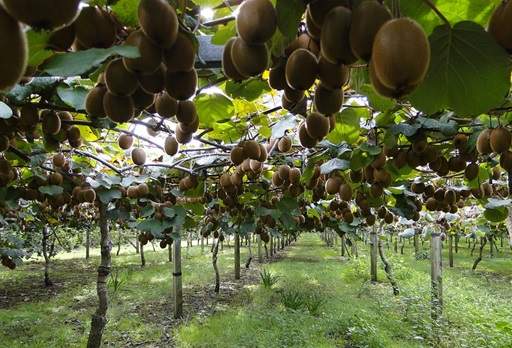
The aim of pruning is to maintain a manageable, easy-to-harvest vine with adequate light and air circulation
Problems, Pests & Diseases
Root rot may occur if kiwi vines are planted in waterlogged conditions, most commonly in clay soils. This can be avoided by planting your vine atop a raised mound of earth to avoid the top part of the root system sitting wet, if your soil does not drain well. On the flip-side, brown-edged, drooping leaves is indicative of drought stress, potentially combined with cold, drying winds. To avoid this issue, ensure your choose a sheltered site preferably against a south-facing wall and well away from any frost pockets and water regularly during prolonged periods of hot, dry weather. Honey fungus will only become a problem if you do not adequately prune your vine, resulting in poor air circulation. If you see evidence of this, use a fungus killer spray and be a bit more aggressive with the secateurs! Finally, kiwi vines can be appealing to cats so if you keep cats or have them in your neighbourhood, consider protecting the roots and lower stems of the vines using cloth or chicken wire to prevent any damage.
Share this page:

